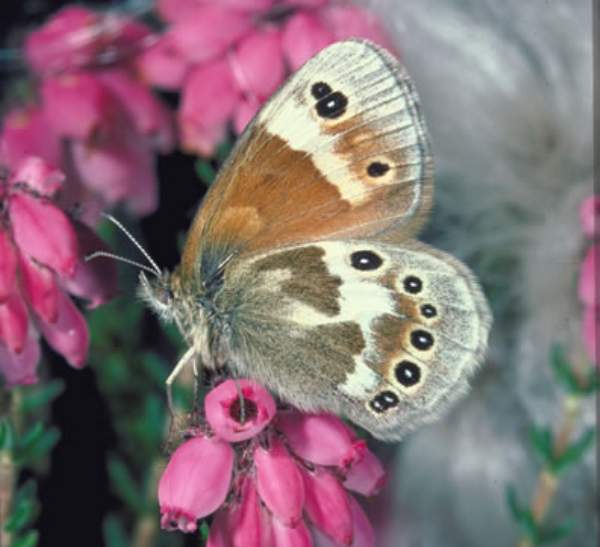Trees Birds Mammals Fish Amphibians Reptiles
Wild Algarve
Bookshop
Large Heath Butterfly - Coenonympha tullia
Phylum: Arthropoda - Class: Insecta - Order: Lepidoptera - Family: Nymphalidae

This is one of the so-called 'browns', and unfortunately across most of Britain, except for northern Scotland and for some parts of Ireland, it is now a localised and uncommon to rare find.
Habitat
Large Heath butterflies are restricted to wetland sites such as lowland raised peat bogs and upland blanket bogs.
Description
With a wingspan of typically 41mm, this medium-sized butterfly rests always with its wings closed. The underwing spots are variable in size depending on location: those in southern England have large spots, while in northern Scotland there is a race of Large Heath butterflies with very small and indistinct spots. Intermediate between these extremes occur in Ireland, Wales and central/northern England.
The Large Heath is one of 39 members of the Coenonympha genus that are currently listed worldwide, and of these 14 have so far been recorded in Europe.
Distribution
Localised in Britain and Ireland, the Large Heath butterfly is also recorded in many parts of northern Europe, Asia and North America.
Lifecycle
The main larval foodplants of Large Heath butterflies are Hare's-tail Cottongrass Eriophorum vaginatum and, less frequently, Common Cottongrass Eriophorum angustifolium.
In Britain and Ireland, Large Heath butterflies can be seen on the wing between mid June and mid August. As in the picture on this page, Large Heath butterflies often nectar on the flowers of Cross-leaved Heath Erica tetralix.
Acknowledgements
This page includes pictures kindly contributed by the Countryside Council for Wales.
Studying butterflies and moths...
Excited by rivers and streams? So are we, and we're pretty sure you would find the Winding River Mystery trilogy of action-packed thrillers gripping reading too. Dead Drift, Dead Cert, and Dead End are Pat O'Reilly's latest river-based novels, and now they are available in ebook format. Full details on our website here...
Buy each volume in ebook format for only £2.47 on Amazon... Paperbacks also available on Amazon at £6.95 each. All proceeds go towards keeping the First Nature website online.
Please Help Us: If you have found this information interesting and useful, please consider helping to keep First Nature online by making a small donation towards the web hosting and internet costs.
Any donations over and above the essential running costs will help support the conservation work of Plantlife, the Rivers Trust and charitable botanic gardens - as do author royalties and publisher proceeds from books by Pat and Sue.